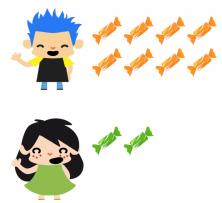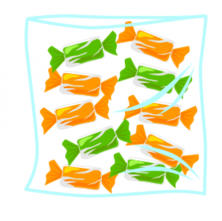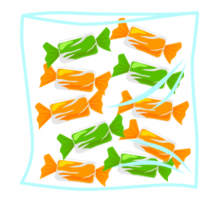What Is a Number?
A number helps us represent and compare quantities without having the objects in front of us.
Caesar and Gabriela will share a bag of candy:
 Caesar says he will eat the orange candies, so Gabriela will eat the green ones. Who will eat more candy?
Caesar says he will eat the orange candies, so Gabriela will eat the green ones. Who will eat more candy?
Let’s compare Caesar’s candy with Gabriela’s:

It’s unfair! Caesar will eat many pieces of candies and Gabriela will eat very few.
Let’s change the bag … Now it is not as easy to know who will have more … right?
Now it is not as easy to know who will have more … right?
To find out who will eat more, we can take the candies out of the bag again and compare them, but we can also … learn the numbers!
The numbers help us count and compare amounts of objects. For example, when we have: How many candies do we have? We say that we have ONE, which is written:
How many candies do we have? We say that we have ONE, which is written:
1
When we have: We say we have TWO candies, and we write:
We say we have TWO candies, and we write:
2
and we will continue with more candy: THREE candies.
THREE candies.

Four candies.

FIVE candies.

SIX candies.

SEVEN candies.
![]()
EIGHT candies
![]()
NINE candies.
And after that ? There are many more! But today we will only learn up to number 9. What can we use numbers for? For one, to not have to always line up the candies in a line to compare quantities. You need to know numbers by memory. That is, we have to memorize (without looking at the candy) to have 1 candy is to have less candy than if we have 2 candies. Or that having 6 pieces of candy is less than having 8 pieces of candy.
Let’s now look at the bag of candy … Caesar will eat 6 and Gabriela will eat 4. Cesar is cheating again! He will eat more candy than Gabriela … what can we do to compensate? We will propose another bag of candies.
Caesar will eat 6 and Gabriela will eat 4. Cesar is cheating again! He will eat more candy than Gabriela … what can we do to compensate? We will propose another bag of candies.
 In this bag, there are 5 pieces of candy for Caesar and 5 pieces of candy for Gabriela. It’s the same number! Now they are going to eat the same amount of candy.
In this bag, there are 5 pieces of candy for Caesar and 5 pieces of candy for Gabriela. It’s the same number! Now they are going to eat the same amount of candy.
But we can do much more with numbers! Imagine that I tell you that my sister bought 8 pieces of licorice and my brother bought 2. Who will eat more licorice? Of course, my sister! Because the number 8 represents a larger quantity than what is represented by the number 2.
What have we learned?
A number helps us represent and compare quantities without having the objects in front of us. So now you know, to learn the numbers to not be fooled with pieces of candies!
At Smartick, you have lots of exercises to keep learning all about numbers.
Learn More:
- Distributive Property of Multiplication with Examples
- How to Solve a 1 Digit Division Problem
- How to Solve Addition Problems
- Using the Number Line to Compare Fractions
- Using Lego Blocks to Help with Addition of Fractions







